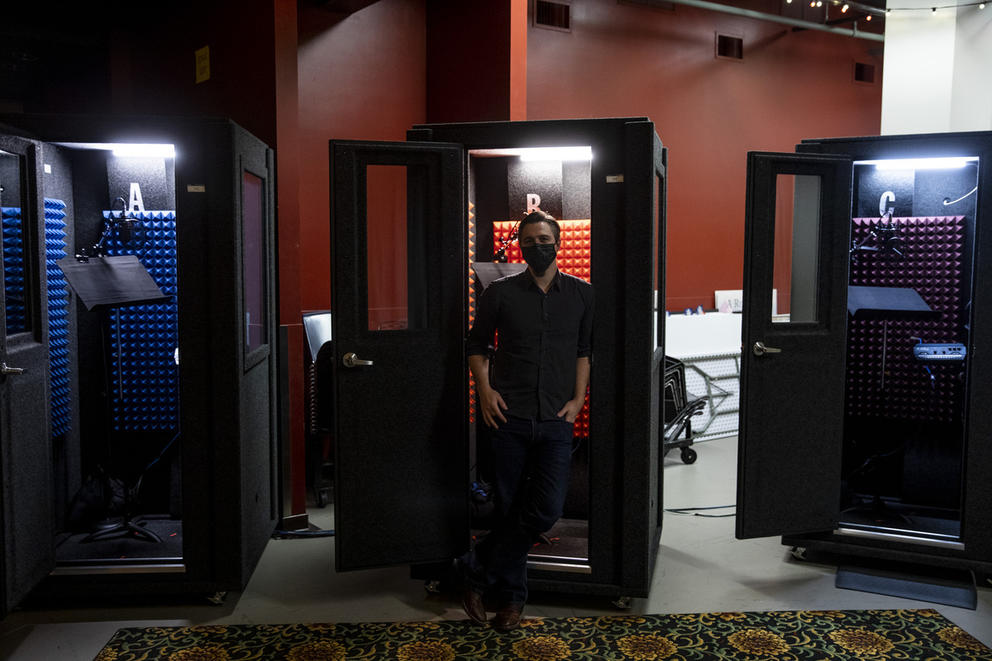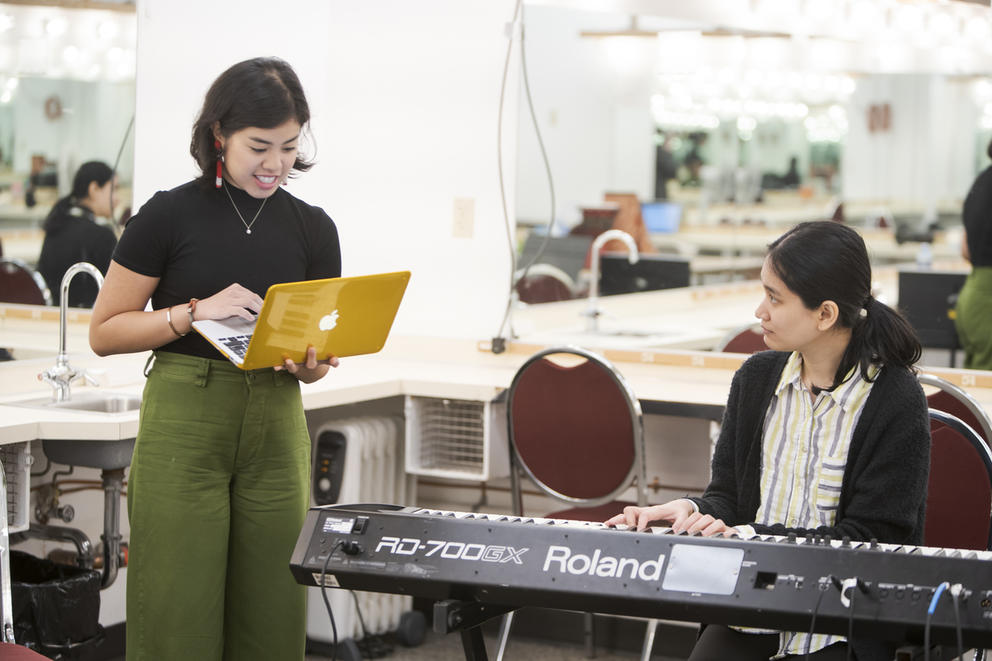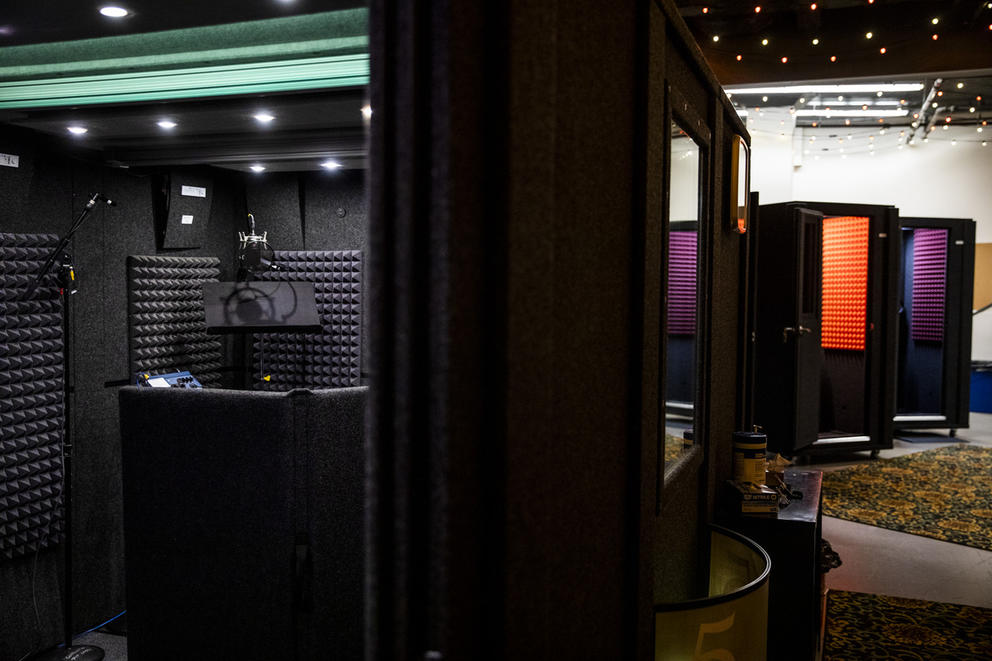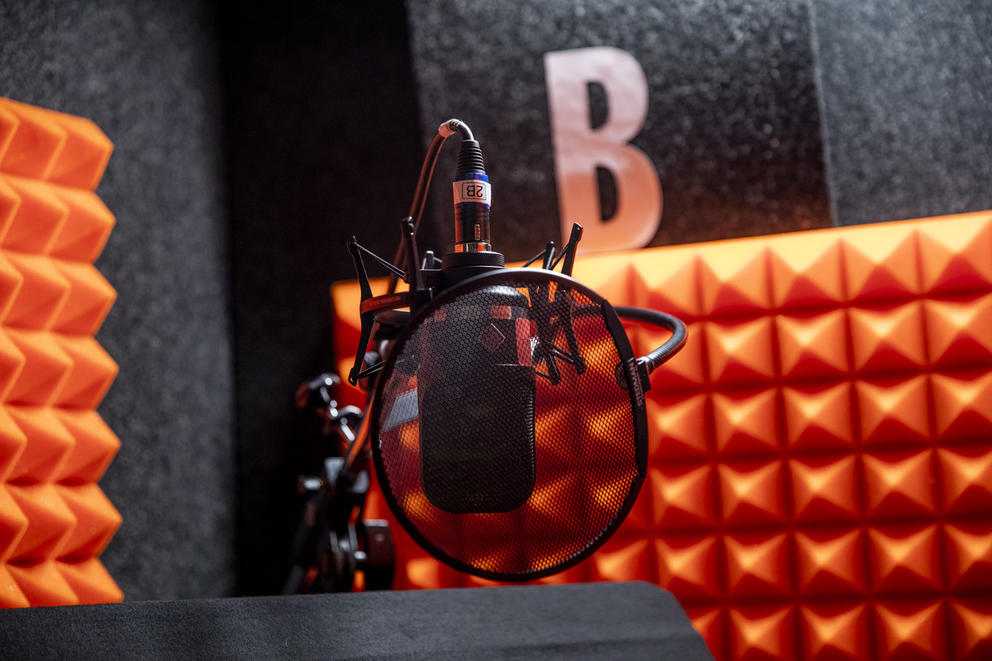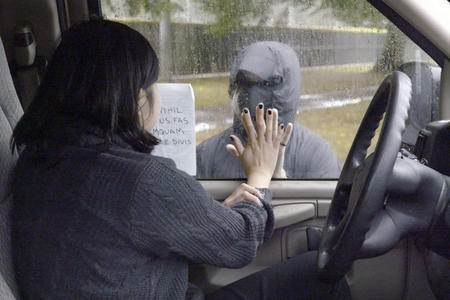The box is a miniature theater set for the play Changer and the Star People, which Renville created with Roger Fernandes in collaboration with Sound Theatre Company. Shepherding Indigenous stories — Coast Salish and Dakota origin tales, in particular — onto the stage and into a Eurocentric canon was to be the realization of a lifelong dream. The play, an Indigenous Futurist vision featuring an all-Indigenous cast, was poised to premiere March 28 at Seattle’s Taproot Theater, but the coronavirus curtailed the plans.
“I really had to grieve,” says Renville, who is Dakota and enrolled in the Sisseton Wahpeton Oyate, “and then decide: Where would this go next?”
The answer: It would transform into a radio play, premiering as a podcast this November.
Now, the coastal scene is evoked with the sounds of shrieking seagulls and crashing waves layered under the actors’ voices.
“It’s funny because as a director and playwright, I was taught that you want to show, not tell,” Renville says. “And literally, for a radio or podcast, it’s the opposite: We have to tell the entire story using only our ears.”
The cast of 'Changer and the Star People,' an Indigenous Futurist play featuring Dakota and Coast Salish origin stories, was poised to premiere March 28 at Seattle’s Taproot Theater, but the coronavirus curtailed the plans. From left to right: Geneva Seaboy, Fern Renville, Roger Fernandes, Johnny Patchamatla, Asriel Willis, Nicole Willis, Casey Wynecoop. (Aaron Jin/Sound Theatre Company)
Sound Theatre Company isn’t the only local theater digitally reviving the radio drama amid coronavirus precautions. With venues still closed, actors out of work and people tiring of Zoom events, Book-It Repertory Theatre, Seattle Shakespeare, The 5th Avenue Theatre, ACT and Seattle Public Theater are finding ways for either new or rejiggered stage plays to make their way into people’s homes — and ears — this fall. With gatherings in the physical theater remaining a distant memory and a far-off prospect, radio drama is making a comeback, via the internet, rather than the airwaves.
Not bad for a century-old art form. In the 1920s, radio drama quickly lodged itself into popular culture along with the then-new technology of the radio itself. Sitting around this wondrous device to listen to radio plays and serial soap operas became a wildly popular escape during the dark days of The Great Depression (ring any bells?). The device’s popularity for storytelling lost out to TV’s visual magic a few decades later (though the smartphone has ushered in a recent “radio revolution” of the podcast and audiobook).
Some have been working to keep the art alive all along, including Feliks Banel, radio historian and founder of Seattle Radio Theatre, which has been producing live holiday radio shows via various local radio stations since 2000. The events are usually cozy affairs. Multiple actors crowd on stage in front of an audience, along with a live piano player and a sound-effects person who, Banel says, will usually be “moving a pair of shoes up and down on a piece of plywood, breaking a glass in a box, ringing a bell or operating an electric telephone to simulate the sound of a phone ringing from the 1950s or 1940s.” Just like in the good ol’ radio drama days.
But Seattle Radio Theatre’s 21st season — kicking off Oct. 29 with the seasonally appropriate A Walk in the Dark — will look very different. No stage, no audience, only a live performance with the cast members in their houses and Banel directing from his basement. (Actors are ready to jump in with lines when someone’s signal drops.) But, Banel says, “There's no substitute for that interaction between the living, breathing, coughing audience and the people standing on the stage. That's the magical part for me.”
Of course, getting any group of living, breathing, coughing humans together is exceptionally dangerous right now. That’s in part why most theaters shifting to audio plays have opted for prerecorded sessions. (It also helps improve audio quality.) Actors rehearse together over videoconferencing, but head into the studio to record their lines animation-movie style: separately, hearing their counterparts’ lines in their theater of the mind.
Instead of on stage, the magic now happens behind the closed doors of foam-padded, shower-sized booths. Three of those, plus a bigger fourth one to encompass a few musicians or a drum set, now stand in a row in the former rehearsal space at The 5th Avenue Theatre. Later this month, singers and musicians will take turns recording lines here for the epic Everest-climbing musical Half the Sky, helmed by Seattle-based director Desdemona Chiang.
Up the street at ACT Theater, actors retreated to seven booths on the stage to record the theater’s 45th production of A Christmas Carol. Unable to see each other’s facial expressions, performers had to rely on memory to conjure Scrooge’s trademark scowl. Seattle Public Theater found a different solution: four actors, more than a dozen feet apart, each reciting lines from different corners of the room at West of Lenin, a theater space in Fremont equipped for audio recording.
Theaters with smaller budgets, such as the volunteer-run Annex Theatre on Capitol Hill, recorded actors mostly from home.
“From an actor perspective, it’s a sweet job because you can work in your sweatpants, you don't punish your face with makeup however many nights per week, and you get as many takes as you need to get your line right,” says Sam Ro, who directed and acted in the first episode of Annex’s detective radio drama series Battle Crow Radio: “What Happened to Kitten Swell: A Palverson and Jiggles Murder Mystery.”
“Despite everyone being physically separate, I found the process to be pretty intimate,” Ro adds. During rehearsal on Zoom, the actors acquired a new mode of close attention. “We often turned our webcams off to just hear each other's voices,” Ro says, “to run through the show and get used to the absence of a face to react to.”
Rosa Joshi of Upstart Crow Collective, an all-female and nonbinary identifying theatrical group, employed a similar cameras-off technique during the rehearsals for an “encore” audio rendition of its hit 2018 production of Richard III, in collaboration with the Seattle Shakespeare Company. (The tale of an aggrandizing, deceitful power monger is available through Nov. 1.)
“I was not watching people, I was listening only,” Joshi says. “This is something I also do often in a regular rehearsal, but in this medium, it became integral to the process.”
It’s not just the actors and directors who reap the benefits from focusing on the words. Listeners do, too, particularly with the Bard’s text, says Seattle Shakespeare Company Artistic Director George Mount. “Back in the day, the Elizabethans, they went to hear a play, not to see a play,” Mount says. “The sounds of the words can create an environment, mood and atmosphere.” It’s there, he says, that “Shakespeare's use of poetic inventions, like alliteration or rhyming or meter and rhythm, really starts coming through.”
Still, says Richard III sound editor Meghan Roche, audio “clean-up” was key, particularly because Upstart Crow recorded over Zoom and a podcasting app. “There’s a reason why most of us don’t love being on Zoom calls for an extended period of time, and a big part of that is ear fatigue,” Roche says. “Because of the compression Zoom does to keep calls going, things sound very harsh and get grating over time...We really wanted to make sure that was not the experience of our listeners.”
Despite the limitations, theaters that have chosen the audio medium as a workaround under coronavirus restrictions have found that it can crack open a trove of possibilities and allow for new artistic feats.
“The thing about audio is that the greatest tool contained within it is the listener’s imagination,” says Gus Menary, artistic director of Book-It Repertory Theater. “What could possibly come even close to being as amazing and detailed as the human imagination?”
For the first time in its 31-year history, Book-It is releasing an all-audio season, featuring five radio plays. Suddenly, mere suggestion and smart sound effects can make the Canterville Ghost appear to walk through people and walls in the holiday classic of the same name. (“Saved us a lot in fog machine budget,” Menary quips.) In the audio sphere, Sherlock can traverse the Himalayas’ vast expanses (in The Mandala of Sherlock Holmes) in just a few minutes. And a chorus of intricately layered whispers can evoke the telepathic battles of Childfinder, Book-It’s season premiere, adapted by Shermona Mitchell from Octavia E. Butler’s short science-fiction story.
“What I’m enjoying with the audio format is the way we can play with proximity — whispers, for example, that one can’t really do on stage,” says Gin Hammond, Childfinder's director. “Also, special effects, such as blasting through portals, become much easier to do with sound than turning off the lights and hoping the actors make it offstage safely,” Hammond says.
Renville and Fernandes had to find a similar auditory trick for the moment when The Changer turns a white woman into a rock (so that she would finally listen). But apart from that, Changer and the Star People didn’t need much reconfiguring for audio, says Roger Fernandes, an artist, educator, oral storyteller and member of the Lower Elwha S’Klallam Tribe.
“Learning storytelling about 30 years ago or so, I was given this exposure to other storytellers and the idea that the word is sufficient, that you don’t need to embellish it with a lot of things,” Fernandes says. “That human beings would sit around a fire for countless human generations, telling stories.
“Some people could dramatize the delivery of words or the characters, or they could maybe add some props, but ultimately, the story spoken stands alone.”
This idea, this history, gives Fernandes a sense that things will turn out all right for the play — and theater at large. “Coming from my history where my parents, that generation, talked about radio acting … it was almost comforting to say, ‘Well, we’re going to do that again.’ ”
Things tend to come full circle, he adds. Theater might too. “At some point, theater will be able to come back having learned some things in this experience of not being able to create stage productions, [having] to rely on some other things,” Fernandes says.
A master of his craft, he pauses, leaving the air fertile for a finale. “Which to me ties in to the idea of human beings,” he says. “We figure things out. We survive.”
Get the latest in local arts and culture
This weekly newsletter brings arts news and cultural events straight to your inbox.

